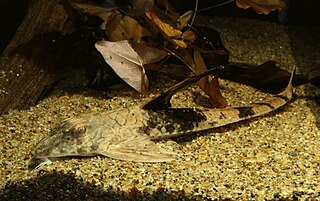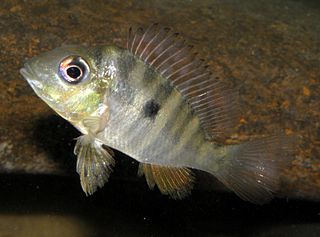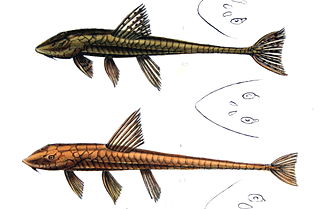
The Iguazu River, also called Rio Iguassu, is a river in Brazil and Argentina. It is an important tributary of the Paraná River. The Iguazu River is 1,320 kilometres (820 mi) long, with a drainage basin of 62,000 square kilometres (24,000 sq mi).

Loricariidae is the largest family of catfish, with 92 genera and just over 680 species. Loricariids originate from freshwater habitats of Costa Rica, Panama, and tropical and subtropical South America. These fish are noted for the bony plates covering their bodies and their suckermouths. Several genera are sold as "plecos", notably the suckermouth catfish, Hypostomus plecostomus, and are popular as aquarium fish.

Otocinclus is a genus of catfish in the family Loricariidae native to South America, commonly known as "dwarf suckers" or "otos". This genus, like other loricariids, is characterized by rows of armour plating covering the body, as well as the underslung suckermouth. They are generally small in size; O. tapirape is the smallest of the species (2.4 cm), while O. flexilis is the biggest (5.5 cm). These species have adaptations that allow them to breathe air. A duct forms at the junction between the esophagus and the stomach and expands into an enlarged, ring-like diverticulum, characteristic of this genus, which allows air-breathing. Otocinclus are popular aquarium fish, and they are often purchased as algae eaters. It is difficult to breed them in captivity, and only wild caught Otocinclus are available to hobbyists. This genus is widely distributed east of the Andes of South America, throughout the lowlands from northern Venezuela to northern Argentina, but are generally absent from the Amazon and the Orinoco lowlands.

Crenicichla is a genus of cichlids native to South America commonly known as the pike cichlids. They are found in most tropical and subtropical freshwater habitats between the Andes and the Atlantic.

Rineloricaria is a genus of freshwater tropical catfish belonging to the family Loricariidae. They are commonly called whiptail catfish because of the long filament that grows out of the tip of the caudal fin that is characteristic of the genus. With the exception of R. altipinnis from Panama, they are native to the rivers of northern and central South America. Some species are regularly seen in the aquarium trade.

Gymnogeophagus is a genus of cichlid fishes from South America, where they are known from various river basins in southern Brazil, Paraguay, Uruguay and northern Argentina. They are part of a group popularly known as eartheaters.

The Hypoptopomatinae are a subfamily of catfishes of the family Loricariidae, composed of 17 genera and approximately 80 species. This subfamily represents about one-tenth of all loricariid species.
Hisonotus is a genus of armored catfishes native to South America. Species of Hisonotus and Curculionichthys are the only representatives of the subfamily Otothyrinae having serrae on the posterior edge of the pectoral fin spine. These species are small fishes, generally found in small fast flowing streams, where they grasp to the branches and leaves of aquatic or subaquatic plants. The species of this genus mostly occur in Atlantic coastal streams of southern Brazil and the Paraguay-Paraná system of southern South America. They are also distributed in the Río de La Plata basin and coastal rivers of southeastern Brazil.

Loricariichthys is a genus of catfishes of the family Loricariidae.
Pareiorhaphis is a genus of catfish in the family Loricariidae native to South America. This genus can be readily distinguished from other neoplecostomines by the unique combination of having fleshy lobes on lateral margins of head ornamented with hypertrophied odontodes on nuptial males, caudal peduncle ovoid in cross section, abdomen usually naked, dorsal fin spinelet ovoid and adipose fin usually present. The color pattern is usually dark brown and mottled with the abdomen white. Most species in to Pareiorhaphis were originally described in Hemipsilichthys. In 1918, Alípio de Miranda-Ribeiro proposed the new genus Pareiorhaphis. Whether Pareiorhaphis is monophyletic or not is currently unknown.

Parotocinclus is a genus of fish in the family Loricariidae native to South America. This genus is distributed through almost all hydrographic systems in South America from the Guyana Shield drainages and Amazon Shield tributaries to the coastal drainages of eastern and southeastern Brazil, including the rio São Francisco basin. Most species have the caudal peduncle oval in cross section. It has been found that Characidium species may interact with P. maculicauda. The small Characidium will follow grazing P. maculicauda, which release particulate matter dislodged from the catfish's foraging.
Eurycheilichthys is a small genus of armored catfishes native to South America.
Eurycheilichthys limulus is a species of armored catfish endemic to Brazil, where it is found in the upper Jacuí River basin. The habitat at the type locality of E. limulus is a small river about 3–5 metres wide with moderate water current, bottom comprising some rocks but mostly sand and a large amount of marginal vegetation. These fishes live among leaves and stalks. This species grows to a length of 4.8 centimetres (1.9 in) SL.
Eurycheilichthys pantherinus is a species of armored catfish from the upper and middle Uruguay River basin in Brazil and Argentina. It inhabits shady, fast-flowing, shallow water, ranging from approximately 200–500 metres in elevation. The substratum is predominantly stones, with little or no macrophytes. This species grows to a length of 4.2 centimetres (1.7 in) SL.
Hisonotus brunneus is a species of catfish in the family Loricariidae. It is native to South America, where it occurs in the Jacuí River and Lagoa dos Patos drainage basins in Brazil. The species reaches 4.2 cm SL.
Hisonotus charrua is a species of catfish in the family Loricariidae. It is native to South America, where it occurs in the Uruguay River and the mouth of the Río de la Plata in Uruguay. The species may be found in both freshwater and brackish environments and reaches 3.6 cm SL.
Rineloricaria reisi is a species of catfish in the family Loricariidae. It is native to South America, where it occurs in the Uruguay River basin, specifically the Piratini River and the Conceição River in Brazil, as well as Misiones Province in Argentina. The species reaches 19.8 cm in standard length and is believed to be a facultative air-breather.
Rineloricaria zaina is a species of catfish in the family Loricariidae. It is native to South America, where it ranges from the confluence of the Canoas River and the Pelotas River to the Ibicuí River in the Uruguay River basin in Brazil, as well as Misiones Province in Argentina. The species reaches 13.9 cm in standard length and is believed to be a facultative air-breather.
Epactionotus advenus is a species of catfish in the family Loricariidae. It is native to South America, where it occurs in the Biguaçu River basin in the state of Santa Catarina in Brazil. The species reaches at least 3.54 cm in standard length. It was described in 2020 as part of a review of the genus Epactionotus conducted by Maria Laura S. Delapieve, Tiago Pinto Carvalho, and Roberto E. Reis. FishBase does not yet list this species.

Psalidodon is a genus of freshwater fish in the family Characidae of the order Characiformes. Some of these fish, like many of their relatives, are kept as aquarium pets and known collectively as tetras.









